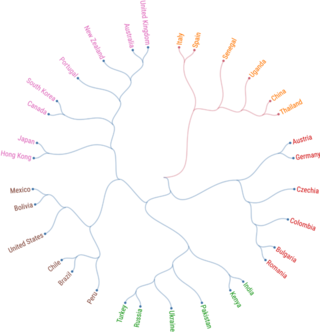Mating
What Drives People’s Social Lives Globally?
Exploring fundamental social motives across 42 societies.
Posted September 26, 2022 Reviewed by Vanessa Lancaster
Key points
- Fundamental social motives in humans include disease avoidance, self-protection, affiliation, status, mate-seeking, mate retention, and kin care.
- We studied these fundamental motives in 42 societies and made our large cross-cultural dataset freely available for anyone to explore.
- Although pop culture and psychological research often focus on the search for romantic partners, we found that most people care more about family
- Cultures cluster by fundamental social motives in familiar and unexpected ways, suggesting new insights and questions.
***Note: this is a guest post first-authored by Cari Pick, who led the research described here. To cite this post: Pick and Al-Shawaf, 2022.***
As you finish an important presentation at work, you feel pride in the respect your colleagues accord you. You leave for the day and call your sister to advise her on how to get through a recent rough patch. As you hang up, your senses go on high alert, and you quicken your step past a large figure lurking in the shadows near your subway station’s entrance.
Relieved to enter the well-lit staircase, you put on your mask and reach for hand sanitizer when you notice the crowded train platform. Soon you speed off to meet up with friends. You are comforted by their support as you discuss disheartening world news.
Before long, you head home to cook dinner with your partner. You chat about the day, enjoying the familiar security of their presence. You reminisce about feeling jitters on your first date and are glad for the effort you made to impress them that evening years ago.
Our days are filled with the pursuit of important social goals, called fundamental social motives: protecting ourselves from dangerous others, avoiding contagious diseases, maintaining friendships, gaining status, finding romantic partners and keeping them, and caring for family.
Much of our behavior is aimed at accomplishing these goals, whether consciously thinking about them or not. Our time and effort are finite, though, so we can’t focus on all the motives all the time. Throughout the day, different motives come to the fore and fade to the back as our surroundings and companions change. At different points in our lives, our focus on particular motives also waxes and wanes. And we differ in the motives we tend to find most important.
In a recent project, we asked: in different cultures around the world—with varying values, religions, ecologies, and more—would we find cultural differences in the motives people tend to find most important? Our international team of researchers studied fundamental social motives in 42 societies across all inhabited continents before and during the COVID-19 pandemic.
We found a universal trend: on average, people around the world rate caring for family (family-related motives) more important than finding romantic partners (mating-related motives). This might sound surprising in light of the predominance of romance-related storylines across movies, television, and fiction, and even the ample focus on mating in psychological research.
Yet when we looked again at our pre-pandemic samples, we continued to find that, on average, family-related motives were more important than mating-related motives for both men and women, singles and people in relationships, college students, and older populations. We also found that people who placed more importance on family-related motives tended to be happier, and people who placed more importance on mating-related motives tended to be higher on measures of depression and anxiety.
In addition to this striking universal pattern, we found differences between cultures in the relative importance of different motives. We looked at which societies tend to cluster with one another based on how similar the overall “profiles” of fundamental social motives were for people we measured in those societies. We found some expected patterns, but some clusterings were interesting and unexpected.
For example, in our sample collected before the pandemic, we did not see typical cross-cultural dichotomies such as developed vs. developing countries or “West vs. Rest.” Instead, as shown in Figure 1, we found that the United States clusters with Mexico and several South American countries. The United Kingdom, Canada, Australia, and New Zealand cluster with wealthy East Asian societies. In addition, Italy and Spain cluster closest to Uganda, Senegal, Thailand, and China.

During the pandemic, in our somewhat different set of countries shown in Figure 2, the United States clusters with several South American countries, and Canada still clusters closest to South Korea. In addition, Lebanon and Colombia cluster with Eastern European countries.

In both samples, we see countries clustering in interesting patterns that might offer new insights into similarities and differences between cultures. Why do we find the patterns that we do? Perhaps they are driven by ecological differences like local disease prevalence, differences in GDP, or income inequality, or are related to other cultural differences like how “tight” or strict a culture’s norms are. We continue to explore these questions, but we have also made the entire dataset publicly available, so anyone can investigate these and other questions that interest them.
Our complicated social relationships offer us safety and support and imbue our lives with meaning. To better understand one another, we need to know more about fundamental social motives' role in shaping our thoughts, feelings, and behaviors. Cross-cultural studies like this one help us better understand the universality and the cultural differences in the weight attached to different social motives worldwide.
Read the full study here.
References




